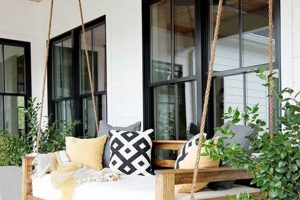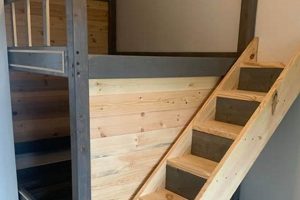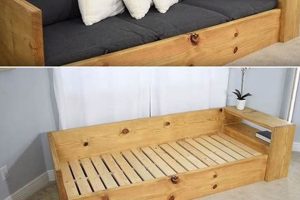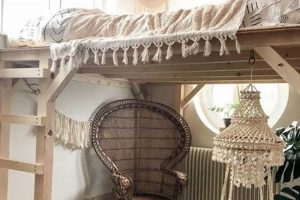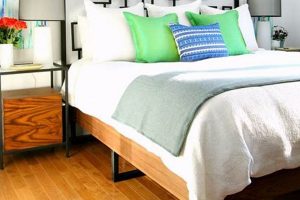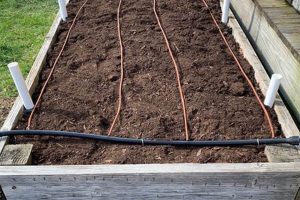A structural framework, often constructed from materials like wood, metal, or durable plastics, provides vertical support for climbing plants cultivated within an elevated garden. This setup enables plants, such as tomatoes, cucumbers, or beans, to grow upwards, maximizing space utilization and enhancing overall garden aesthetics. One example includes a wooden frame attached to the sides of a planting box, with interwoven twine creating a climbing surface.
The utilization of vertical gardening structures in conjunction with elevated planting areas offers several advantages. These structures promote improved air circulation, which can minimize the risk of fungal diseases. Furthermore, they facilitate easier harvesting and maintenance of crops. Historically, the concept of vertical gardening dates back to ancient civilizations, with modern adaptations providing solutions for space-constrained urban environments and gardeners seeking enhanced productivity.
The subsequent sections will explore various design considerations, material selection criteria, construction techniques, and plant selection strategies pertinent to effectively integrating a climbing support system with an elevated garden.
Essential Considerations for Elevated Garden Climbing Supports
Implementing vertical supports for plants within elevated gardens necessitates careful planning and execution. The following guidelines provide practical advice for optimal design and construction.
Tip 1: Structural Integrity: Prioritize the framework’s stability to withstand plant weight and environmental factors. Utilize appropriately sized lumber or metal with adequate bracing.
Tip 2: Material Selection: Choose materials resistant to moisture and decay. Untreated wood degrades rapidly; consider cedar, redwood, or pressure-treated lumber. Metal options should be rust-resistant.
Tip 3: Anchor Placement: Securely anchor the support to the raised bed frame. Use screws or bolts designed for exterior applications to ensure long-term stability.
Tip 4: Plant Compatibility: Select a design suitable for the specific plant species. Heavier vines require more robust support than lighter climbing vegetables.
Tip 5: Accessibility: Design the structure to allow for easy access to plants for pruning, harvesting, and pest control. Consider incorporating walkways or removable sections.
Tip 6: Height Considerations: Determine the appropriate height of the climbing support based on the mature size of the intended plant. Overly tall structures can be difficult to manage, while insufficient height restricts growth.
Tip 7: Drainage Considerations: Ensure that the base of the support structure does not impede drainage from the raised bed, as this can lead to waterlogged soil and root rot.
Adhering to these recommendations enhances the functionality and longevity of vertical supports within elevated gardens, contributing to increased yield and improved aesthetics.
The subsequent section will address specific design plans and construction techniques applicable to various plant types and garden layouts.
1. Structural Stability
Structural stability is a foundational prerequisite for any successful implementation of a garden structure providing vertical plant support. The effectiveness of the installation hinges directly on its capacity to endure imposed loads, including the weight of mature plants, environmental factors such as wind, and potential snow accumulation. Insufficient structural integrity results in collapse, causing plant damage or total loss, alongside potential safety hazards within the garden.
For instance, a support constructed from inadequately sized lumber will likely fail under the weight of a mature tomato plant laden with fruit. Conversely, a framework meticulously assembled with appropriate lumber dimensions and robust joinery, secured with weather-resistant hardware, offers a long-lasting, stable structure. The selection of suitable materials, considering both strength and resistance to degradation from environmental exposure, is paramount.
Therefore, understanding and prioritizing structural stability is not merely a design consideration, but a critical determinant of the overall success and longevity of garden structure. Implementing proper construction techniques and material choices mitigates risks and ensures the sustained functionality of the vertical support system, maximizing yields and maintaining garden aesthetics.
2. Material Durability
The longevity and efficacy of a do-it-yourself vertical plant support inextricably depend upon the inherent durability of the materials employed in its construction. Material selection directly influences the structure’s ability to withstand environmental stressors, including moisture, temperature fluctuations, ultraviolet radiation, and physical strain from plant growth. Premature degradation compromises the structural integrity, potentially leading to collapse and loss of the supported plants. For example, utilizing untreated softwood in a humid climate results in rapid decay, necessitating frequent repairs or replacements. Therefore, material durability is not merely a cosmetic consideration, but a fundamental determinant of the system’s long-term viability and cost-effectiveness.
Consider the comparative performance of various materials. Untreated wood, while readily available and initially inexpensive, exhibits limited resistance to decay and insect infestation. Conversely, naturally durable woods such as cedar or redwood, or pressure-treated lumber, provide enhanced resistance to these factors, extending the lifespan of the support structure. Similarly, metal components, if not properly coated or selected for corrosion resistance, will succumb to rust, compromising their structural integrity. The selection process should therefore prioritize materials known for their resistance to degradation under the specific environmental conditions of the garden.
In summary, the investment in durable materials is paramount for ensuring the long-term success and sustainability of do-it-yourself vertical plant supports. This necessitates a careful assessment of environmental factors and a deliberate selection of materials that can withstand these challenges. While initial costs may be higher for more durable options, the reduction in maintenance, repairs, and premature replacements ultimately results in a more cost-effective and reliable solution. The selection of durable materials is a critical component of a well-designed and effectively constructed vertical support system.
3. Plant Support
Effective plant support is a critical determinant of success when integrating climbing or vining plants with a do-it-yourself elevated garden vertical support system. The provision of adequate physical scaffolding enables optimal growth, facilitates efficient resource allocation, and maximizes yield potential. Absent sufficient support, plants may experience reduced air circulation, increased susceptibility to disease, and diminished productivity. Therefore, understanding and implementing appropriate plant support mechanisms is essential for realizing the full benefits of a combined elevated garden and vertical growing system.
- Vertical Growth Guidance
Plant support mechanisms provide a directional framework, guiding the plant’s growth upwards rather than allowing it to sprawl horizontally. This vertical orientation optimizes sunlight exposure, promoting photosynthesis and fruit production. An example includes utilizing interwoven twine or netting affixed to a wooden frame to direct the growth of cucumber vines within a raised bed. The implications are improved fruit yield per unit area and enhanced air circulation, minimizing the risk of fungal diseases.
- Weight Distribution and Load Management
The framework effectively distributes the weight of the plant, preventing stem breakage or structural failure due to heavy fruit loads or vigorous growth. Consider a tomato plant laden with ripening fruits; a sturdy cage or trellis system disperses the weight, preventing the plant from collapsing. The result is reduced crop loss and increased plant health, fostering sustained productivity throughout the growing season.
- Improved Air Circulation and Disease Prevention
Elevating the plant canopy improves air circulation around leaves and stems, reducing humidity and minimizing the incidence of fungal diseases such as powdery mildew. For instance, supporting squash vines off the ground allows for greater airflow, preventing moisture accumulation and discouraging fungal growth. This leads to healthier plants, reduced reliance on chemical treatments, and increased crop yields.
- Enhanced Accessibility for Maintenance and Harvesting
Proper plant support facilitates easier access for pruning, pest control, and harvesting. Raising plants vertically brings fruits and foliage within convenient reach, simplifying garden maintenance tasks. A vertically supported bean plant, for example, allows for easy harvesting without bending or kneeling, reducing physical strain and saving time. The implications are increased efficiency, reduced labor requirements, and improved overall gardening experience.
These facets collectively highlight the integral role of plant support in maximizing the benefits of combining elevated gardens with vertical support systems. The careful selection and implementation of appropriate support mechanisms, tailored to the specific needs of the chosen plant species, directly impacts plant health, productivity, and the overall success of the gardening endeavor. The integration of these supports contributes to a more efficient, aesthetically pleasing, and productive gardening experience.
4. Space Optimization
Space optimization, when considered in conjunction with self-constructed vertical support structures for elevated gardens, represents a synergistic approach to maximizing plant yield within constrained areas. The cause-and-effect relationship is clear: limited horizontal space necessitates vertical growth, which, in turn, requires tailored support systems. The importance of space optimization as a design component is underscored by the increasing urbanization and diminishing availability of traditional gardening land. Real-life examples include urban gardeners utilizing vertical structures to cultivate climbing vegetables, such as cucumbers and beans, in limited balcony or patio spaces. The practical significance of understanding this interplay is that it empowers gardeners to achieve significant crop production in areas otherwise unsuitable for traditional gardening methods.
Further analysis reveals that space optimization extends beyond simply growing upwards. It encompasses strategic plant selection, the arrangement of structures to maximize sunlight exposure, and the efficient utilization of resources, such as water and nutrients. For instance, a south-facing elevated garden bed, equipped with a vertical trellis, can support multiple layers of plants, with taller, climbing species positioned at the back and shorter, sun-tolerant varieties placed at the front. This arrangement effectively utilizes all available space and light. Practical applications also involve the selection of compact or dwarf varieties of climbing plants, specifically bred for container gardening, further enhancing space efficiency. Moreover, incorporating features such as integrated watering systems and compost bins within the elevated garden design can minimize resource wastage and improve overall sustainability.
In conclusion, the symbiotic relationship between space optimization and self-constructed vertical supports for elevated gardens provides a viable solution for maximizing plant yields in constrained environments. Challenges remain in adapting designs to specific plant species and environmental conditions. However, by prioritizing efficient space utilization, strategic plant selection, and resource optimization, gardeners can transform limited areas into productive and aesthetically pleasing food production systems. The overarching theme emphasizes the importance of innovative gardening techniques in addressing the growing need for sustainable and locally sourced food production in urban environments.
5. Aesthetic Integration
Aesthetic integration, when viewed in the context of a self-constructed vertical support system for an elevated garden, signifies the deliberate harmonization of functional gardening elements with the surrounding environment. It represents more than mere visual appeal; it embodies a design philosophy that seeks to enhance the overall garden experience through the seamless blending of structural components with the natural landscape or architectural setting.
- Material Selection and Harmony
The selection of materials for a vertical support structure can significantly impact its aesthetic integration. For instance, using reclaimed wood can impart a rustic charm, blending seamlessly with a cottage-style garden. In contrast, sleek metal structures can complement a modern, minimalist outdoor space. The implications are profound, dictating the overall ambiance and visual continuity within the garden. Careful consideration should be given to material colors, textures, and finishes to ensure they align with the existing environment.
- Form and Proportion Considerations
The form and proportion of the vertical support structure relative to the elevated garden bed and surrounding landscape is crucial. A towering, disproportionate structure can overwhelm a small garden, while a diminutive support may be visually insignificant. Designing with scale and proportion in mind creates a balanced and harmonious aesthetic. For example, a low, wide elevated bed might be paired with a similarly proportioned horizontal trellis, creating a cohesive visual unit.
- Integration with Existing Architectural Elements
When a self-constructed vertical support system is situated near a dwelling, integrating its design with existing architectural elements is essential. This may involve matching the color of the support structure to the home’s trim, echoing architectural details in the trellis design, or using similar materials. A practical example would be mirroring the clean lines of a modern house in the design of a metal support structure, fostering a unified aesthetic between the garden and the built environment.
- Plant Selection and Visual Harmony
The selection of plants to be supported by the vertical structure plays a vital role in its aesthetic integration. Choosing plants with complementary colors, textures, and growth habits enhances the visual appeal of the support system. For instance, training flowering vines such as clematis or wisteria along a trellis creates a visually stunning focal point, while using foliage plants with varied textures can add depth and interest. Consideration should also be given to the seasonal changes in plant appearance and how they contribute to the garden’s overall aesthetic throughout the year.
Aesthetic integration, therefore, is not a superficial add-on but an intrinsic design consideration for any do-it-yourself vertical support system intended for an elevated garden. By carefully considering material selection, form and proportion, architectural integration, and plant selection, it is possible to create a garden space that is both functional and visually appealing, enhancing the overall outdoor living experience.
Frequently Asked Questions
This section addresses common inquiries regarding the design, construction, and implementation of vertical support structures designed for use with elevated garden beds. The objective is to provide clear and concise answers to frequently encountered issues.
Question 1: What constitutes the primary benefit of integrating a vertical support structure with an elevated garden bed?
The primary benefit lies in the maximization of space utilization, particularly in environments with limited horizontal area. Integrating a vertical element allows for the cultivation of climbing plant species, such as vining vegetables or flowering vines, that would otherwise require significantly more ground space.
Question 2: What materials are most suitable for constructing a durable vertical support structure?
Optimal material selection includes naturally decay-resistant woods like cedar or redwood, pressure-treated lumber, or corrosion-resistant metals such as galvanized steel or aluminum. The specific choice should be predicated on budgetary constraints, aesthetic preferences, and the anticipated load-bearing requirements.
Question 3: How should the structural integrity of a vertical support be assessed prior to planting?
Before introducing plants, the structure should be subjected to a load test. This involves applying a force approximating the anticipated weight of mature plants, including fruits or flowers, to identify any points of weakness or instability. Reinforcements should be implemented as necessary.
Question 4: What strategies can be employed to prevent disease transmission among plants growing on a vertical support?
Maintaining adequate spacing between plants, promoting good air circulation, and practicing diligent sanitation measures, such as pruning away diseased foliage, are essential. Employing disease-resistant plant varieties further mitigates the risk of widespread infection.
Question 5: How does one ensure proper anchoring of a vertical support structure to an elevated garden bed?
Secure anchoring can be achieved through the use of appropriately sized screws, bolts, or brackets designed for exterior applications. The method of attachment should be compatible with the materials of both the support structure and the elevated bed, ensuring a stable and durable connection.
Question 6: What factors influence the selection of plants best suited for vertical growth in an elevated garden?
Considerations include the plant’s mature size, climbing habit, sunlight requirements, and susceptibility to pests or diseases. Selecting species that are well-adapted to the local climate and exhibit manageable growth patterns is crucial for long-term success.
The successful implementation of vertical support structures in elevated gardens hinges on careful planning, material selection, and ongoing maintenance. Addressing these key questions provides a foundation for informed decision-making and optimized plant cultivation.
The subsequent section will address advanced design techniques and innovative approaches to vertical gardening within elevated bed systems.
Conclusion
The preceding exploration has elucidated the multifaceted nature of constructing vertical support systems integrated with elevated gardens. From structural integrity and material durability to plant support, space optimization, and aesthetic integration, each element contributes to the overall success of these installations. The information presented underscores the importance of meticulous planning, informed material selection, and a thorough understanding of the horticultural principles governing plant growth.
Effective implementation of a diy raised bed trellis system requires sustained diligence and an ongoing commitment to adapting designs to meet the specific needs of both the cultivated plants and the surrounding environment. By adhering to established best practices and continually seeking innovative solutions, gardeners can maximize crop yields, enhance the aesthetic appeal of their landscapes, and contribute to the advancement of sustainable food production practices.


